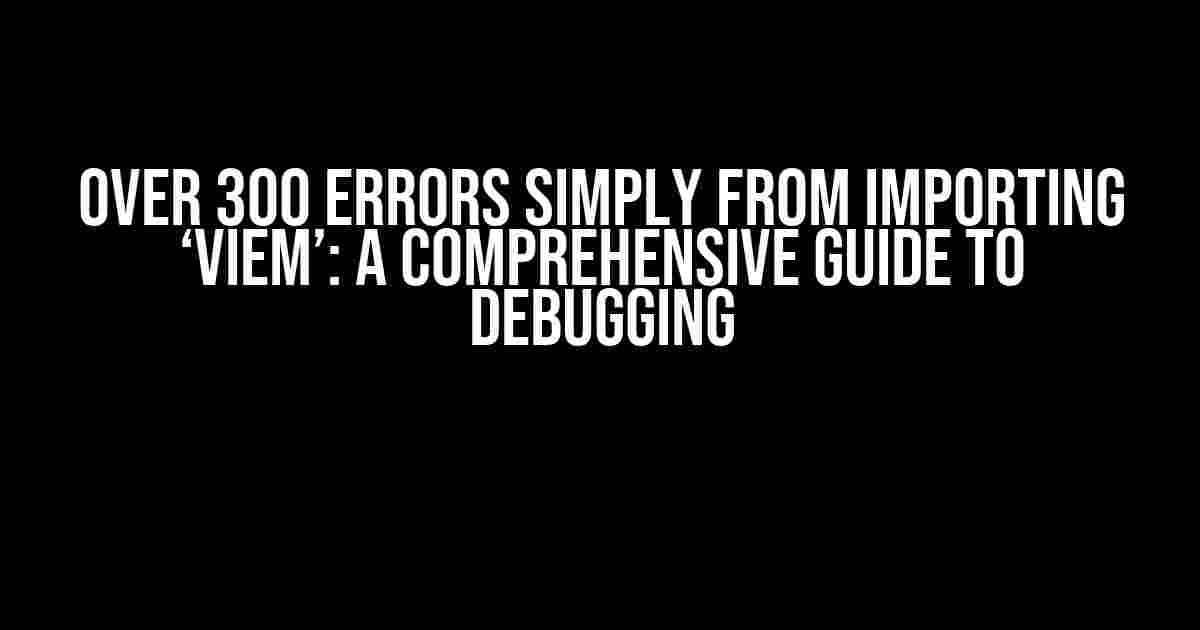Have you ever encountered the frustrating issue of importing ‘viem’ and being bombarded with over 300 errors? You’re not alone! This article will walk you through a step-by-step guide on how to identify and fix these errors, so you can get back to coding in no time.
Understanding the Issue
The ‘viem’ package is a popular Vue.js module that provides a simple and efficient way to manage Vue components. However, due to its complex nature, importing ‘viem’ can sometimes lead to a plethora of errors. These errors can be categorized into three main groups:
- Dependency issues
- Version conflicts
- Syntax errors
In this article, we’ll explore each of these categories and provide practical solutions to resolve them.
Dependency Issues
Dependency issues arise when the modules required by ‘viem’ are not properly installed or configured. To resolve these issues, follow these steps:
- Check if you have installed the required dependencies by running
npm lsoryarn lsin your terminal. - Make sure you have the latest version of Vue.js installed by running
npm install vue@latestoryarn add vue@latest. - If you’re using a Vue.js version older than 2.5, upgrade to the latest version by running
npm install vue@2.5oryarn add vue@2.5.
npm install vue@latest
npm install viem
Version Conflicts
Version conflicts occur when different versions of the same module are installed, causing conflicts. To resolve version conflicts:
- Check the version of ‘viem’ installed by running
npm ls viemoryarn ls viem. - Make sure you’re using the latest version of ‘viem’ by running
npm install viem@latestoryarn add viem@latest. - If you’re using a pinned version of ‘viem’, try upgrading to the latest version by running
npm install viem@^latestoryarn add viem@^latest.
npm uninstall viem
npm install viem@latest
Syntax Errors
Syntax errors occur due to incorrect usage of ‘viem’ or other modules. To resolve syntax errors:
- Check your import statement for any typos or incorrect syntax. Make sure it’s correctly formatted as follows:
import { createApp } from 'vue';
import { createViem } from 'viem';
const app = createApp(App);
const viem = createViem(app);
If you’re still encountering errors, try the following:
- Check your Vue.js version and make sure it’s compatible with the version of ‘viem’ you’re using.
- Verify that you’ve correctly installed the required dependencies.
Common Errors and Solutions
| Error Message | Solution |
|---|---|
| Cannot find module ‘viem’ | Run npm install viem or yarn add viem to install the ‘viem’ module. |
| Version conflict: 1.2.3 vs 1.3.0 | Run npm uninstall viem and then npm install viem@latest to upgrade to the latest version. |
| SyntaxError: Unexpected token import | Check your import statement for any typos or incorrect syntax. Make sure it’s correctly formatted. |
Conclusion
In conclusion, resolving over 300 errors simply from importing ‘viem’ requires a step-by-step approach to identify and fix the underlying issues. By following the instructions outlined in this article, you should be able to resolve dependency issues, version conflicts, and syntax errors. Remember to always check your import statements, verify your dependencies, and upgrade to the latest versions of ‘viem’ and Vue.js.
With patience and persistence, you’ll be able to overcome these errors and successfully integrate ‘viem’ into your Vue.js project. Happy coding!
Frequently Asked Question
imports can be a real pain in the code! Ever wondered what’s behind the infamous “Over 300 errors simply from importing ‘viem'” issue? Let’s dive into the most frequently asked questions about this frustrating error!
What is the main reason behind the “Over 300 errors” issue when importing ‘viem’?
The primary culprit behind this error is usually a mismatch between the versions of Vue and Vue-router. When the versions are incompatible, it can trigger a cascade of errors, leading to the infamous “Over 300 errors” issue!
How can I identify the incompatible versions of Vue and Vue-router?
Check your package.json file to see the versions of Vue and Vue-router installed in your project. You can also use the npm ls vue vue-router command to list the versions. If you’re unsure, try updating or downgrading the versions to match the recommended combinations.
What are the recommended version combinations for Vue and Vue-router?
For Vue 2.x, use Vue-router 2.x. For Vue 3.x, use Vue-router 4.x. Make sure to check the official documentation for the most up-to-date version combinations.
Can I use other solutions to fix the “Over 300 errors” issue?
Yes, you can try updating or reinstalling other dependencies, cleaning the npm cache, or even deleting the node_modules folder and running npm install again. However, identifying and resolving the version mismatch is usually the most effective solution.
How can I prevent similar issues in the future?
To avoid similar issues, make sure to regularly check for updates and maintain consistent versioning across your dependencies. Use tools like npm audit and npm outdated to identify potential issues before they become major problems!
